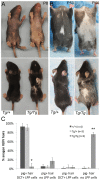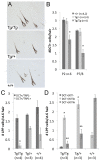A dual role for SOX10 in the maintenance of the postnatal melanocyte lineage and the differentiation of melanocyte stem cell progenitors
- PMID: 23935512
- PMCID: PMC3723529
- DOI: 10.1371/journal.pgen.1003644
A dual role for SOX10 in the maintenance of the postnatal melanocyte lineage and the differentiation of melanocyte stem cell progenitors
Abstract
During embryogenesis, the transcription factor, Sox10, drives the survival and differentiation of the melanocyte lineage. However, the role that Sox10 plays in postnatal melanocytes is not established. We show in vivo that melanocyte stem cells (McSCs) and more differentiated melanocytes express SOX10 but that McSCs remain undifferentiated. Sox10 knockout (Sox10(fl); Tg(Tyr::CreER)) results in loss of both McSCs and differentiated melanocytes, while overexpression of Sox10 (Tg(DctSox10)) causes premature differentiation and loss of McSCs, leading to hair graying. This suggests that levels of SOX10 are key to normal McSC function and Sox10 must be downregulated for McSC establishment and maintenance. We examined whether the mechanism of Tg(DctSox10) hair graying is through increased expression of Mitf, a target of SOX10, by asking if haploinsufficiency for Mitf (Mitf(vga9) ) can rescue hair graying in Tg(DctSox10) animals. Surprisingly, Mitf(vga9) does not mitigate but exacerbates Tg(DctSox10) hair graying suggesting that MITF participates in the negative regulation of Sox10 in McSCs. These observations demonstrate that while SOX10 is necessary to maintain the postnatal melanocyte lineage it is simultaneously prevented from driving differentiation in the McSCs. This data illustrates how tissue-specific stem cells can arise from lineage-specified precursors through the regulation of the very transcription factors important in defining that lineage.
Conflict of interest statement
The authors have declared that no competing interests exist.
Figures







Similar articles
-
An iterative genetic and dynamical modelling approach identifies novel features of the gene regulatory network underlying melanocyte development.PLoS Genet. 2011 Sep;7(9):e1002265. doi: 10.1371/journal.pgen.1002265. Epub 2011 Sep 1. PLoS Genet. 2011. PMID: 21909283 Free PMC article.
-
CXCL12 regulates differentiation of human immature melanocyte precursors as well as their migration.Arch Dermatol Res. 2019 Jan;311(1):55-62. doi: 10.1007/s00403-018-1880-2. Epub 2018 Nov 27. Arch Dermatol Res. 2019. PMID: 30483878
-
A direct link between MITF, innate immunity, and hair graying.PLoS Biol. 2018 May 3;16(5):e2003648. doi: 10.1371/journal.pbio.2003648. eCollection 2018 May. PLoS Biol. 2018. PMID: 29723194 Free PMC article.
-
Checkpoints of melanocyte stem cell development.Sci STKE. 2005 Aug 23;2005(298):pe42. doi: 10.1126/stke.2982005pe42. Sci STKE. 2005. PMID: 16118396 Review.
-
Aging, graying and loss of melanocyte stem cells.Stem Cell Rev. 2007 Fall;3(3):212-7. doi: 10.1007/s12015-007-0028-0. Stem Cell Rev. 2007. PMID: 17917134 Review.
Cited by
-
Skin tissue regeneration for burn injury.Stem Cell Res Ther. 2019 Mar 15;10(1):94. doi: 10.1186/s13287-019-1203-3. Stem Cell Res Ther. 2019. PMID: 30876456 Free PMC article. Review.
-
Transcription factor profiling identifies Sox9 as regulator of proliferation and differentiation in corneal epithelial stem/progenitor cells.Sci Rep. 2018 Jul 6;8(1):10268. doi: 10.1038/s41598-018-28596-3. Sci Rep. 2018. PMID: 29980721 Free PMC article.
-
Ectopic differentiation of melanocyte stem cells is influenced by genetic background.Pigment Cell Melanoma Res. 2015 Mar;28(2):223-8. doi: 10.1111/pcmr.12344. Epub 2015 Jan 5. Pigment Cell Melanoma Res. 2015. PMID: 25495036 Free PMC article.
-
Stress-associated ectopic differentiation of melanocyte stem cells and ORS amelanotic melanocytes in an ex vivo human hair follicle model.Exp Dermatol. 2021 Apr;30(4):578-587. doi: 10.1111/exd.14309. Epub 2021 Mar 3. Exp Dermatol. 2021. PMID: 33598985 Free PMC article.
-
Dissecting Wnt Signaling for Melanocyte Regulation during Wound Healing.J Invest Dermatol. 2018 Jul;138(7):1591-1600. doi: 10.1016/j.jid.2018.01.030. Epub 2018 Feb 8. J Invest Dermatol. 2018. PMID: 29428355 Free PMC article.
References
-
- Tobin DJ, Paus R (2001) Graying: gerontobiology of the hair follicle pigmentary unit. Exp Gerontol 36: 29–54. - PubMed
-
- Nishimura EK, Jordan SA, Oshima H, Yoshida H, Osawa M, et al. (2002) Dominant role of the niche in melanocyte stem-cell fate determination. Nature 416: 854–860 doi:10.1038/416854a - DOI - PubMed
-
- Mak S-S, Moriyama M, Nishioka E, Osawa M, Nishikawa S-I (2006) Indispensable role of Bcl2 in the development of the melanocyte stem cell. Dev Biol 291: 144–153 doi:10.1016/j.ydbio.2005.12.025 - DOI - PubMed
-
- Osawa M, Egawa G, Mak S-S, Moriyama M, Freter R, et al. (2005) Molecular characterization of melanocyte stem cells in their niche. Development 132: 5589–5599 doi:10.1242/dev.02161 - DOI - PubMed
-
- Botchkareva NV, Botchkarev VA, Gilchrest BA (2003) Fate of melanocytes during development of the hair follicle pigmentary unit. J Investig Dermatol Symp Proc 8: 76–79 doi:10.1046/j.1523-1747.2003.12176.x - DOI - PubMed
Publication types
MeSH terms
Substances
Grants and funding
LinkOut - more resources
Full Text Sources
Other Literature Sources
Medical
Molecular Biology Databases
Miscellaneous

